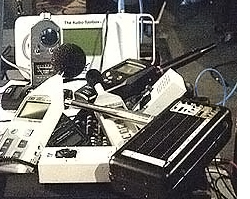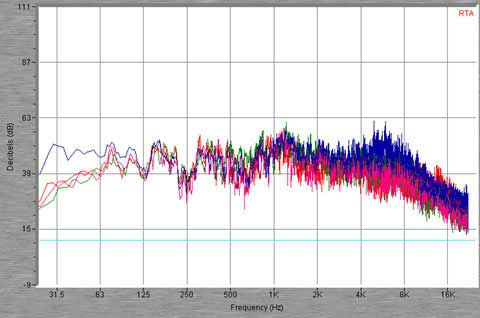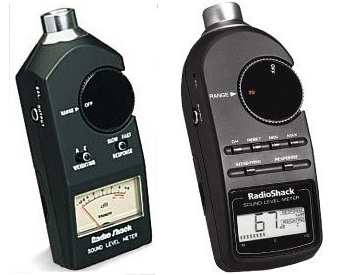
One relevant and valid relative SPL measurement that can be made in sound reinforcement work is determining the even-ness of coverage provided by a loudspeaker system.
In this case virtually any SLM is able to indicate any deviations that may exist in the sound pressure levels as the SLM is moved about the coverage area of the loudspeaker system.
In a similar manner we can observe changes in relative SPL as the gain of a sound system is brought up and down and we can accurately determine changes in SPL as a noise source (machinery, for example) is turned on and off.
Available SLMs
As stated previously, SPL measurements made with Class-2 and Class-3 SLM’s provide sufficiently accurate (within +/- 1.0 dB) readings for what we require in sound reinforcement work.
Until recently, SLM devices that met this level of accuracy were prohibitively expensive ($1,200 and up).
Most of the old classic SLM’s are cumbersome to set up and, due to their inherently fragile construction, are seldom used for touring sound or on-site installation work.
Without question the most common SLMs used by live sound folks have been those made by Radio Shack. These appear to represent a very good value, are easy to use and are readily available almost anywhere in North America.
In researching for this article I have found that, along with all of the sound system operators and contractors who own a Radio Shack SLM (or two), there are large numbers of other users including university physics/acoustics and biology departments, municipalities, hi-fi enthusiasts, and theater system installers and property management companies.
And there are at least a few websites devoted to using the Radio Shack SLM for tweaking hi-fi, project studio and sound reinforcement loudspeaker systems and for simple noise measurement.
The original Radio Shack model 33-2050 utilizes an analog meter display and has been in production for the past few decades, and several years ago, the model 33-2055 was introduced, providing a “digital” (alphanumeric) LCD display, recessed and better-protected switches and a maximum/minimum measurement function.
Otherwise, these two models employ the same microphone, base circuitry and battery complement.
Alternative SPL Measurement Tools
One alternative to the stand-alone SLM’s described in this article is the SLM function included with some of the better portable RTA’s (real time analyzers) that are often employed for live sound and acoustic measurement.
Models from Ivie, Audio Control, and GoldLine all provide accurate broadband sound level measurement (Class-2 or Class-1, depending on the microphone used) plus octave and 1/3-octave spectrum analysis.

This combination of measurements is very useful for determining both the SPL and the frequency components of the sound/noise under con sideration.
Most, if not all, of the current crop of computer-based electroacoustic measurement system provide an SPL function along with their frequency and time-related measurements. Of these, SIM from Meyer Sound and TEF from Goldline are sold with microphones and are calibrated at the factory.
Smaart (any version), SpectraFoo, SysSid, PC-RTA and other similar systems utilize third-party microphones and preamps that must be calibrated by the end-user, using an acoustic calibrator or piston.
Once calibrated, these systems provide very good accuracy and feature a number of variables (weighting filters, etc).
Unfortunately, they are not really “handheld” nor nearly as portable as stand-alone SLMs. And (most importantly) they do not retain their calibration from site to site and therefore require an acoustic calibrator for continued use in measuring absolute SPL’s.
Another product that is a variation of a SLM deserves mention here. SPL “management” systems have been available for perhaps a decade and are directly related to the issues of sound system volume levels.
These simply employ microphones and a software-based SLM system that provides either an obnoxious visual warning or more extreme reactive functions (such as muting of the sound system signal!) when the predetermined SPL limit has been reached or surpassed.
Calibration
In situations where the accuracy of sound level measurements must be recorded and/or verified, it is necessary to calibrate the measurement system both before and after the measurements are made.
Software-based electroacoustic measurement systems that feature an SLM function also need to be calibrated if used for absolute SPL measurements.
An acoustic calibrator provides the standard 94 dB or 114 dB (or both) 1 kHz test tone and should also include the proper size opening or adaptor rings for the microphone(s) you intend to employ.
As is the case with SLMs, calibration devices are manufactured to several levels of tolerance (see table near beginning of article) and they have historically been prohibitively expensive.
Recently there have been several acoustic calibrators introduced that provide very good accuracy for sound system and acoustics measurement.
SLMs may also be calibrated with a pistonphone, but the cost of this device is prohibitively high and the high level of accuracy it provides is not practical for most general sound system related measurements.
Why We Use Them
The simple and snappy answer as to why we use SLMs: so we can know what’s going on.
The need for accurate and repeatable sound level measurement is due simply to the tendency for humans to aurally perceive sound in a very subjective manner. This applies to all aspects of sound perception in the audio field: frequency content, mix “correctness”, system EQ, dynamics, etc.
At some point or another we will disagree on the relative loudness being produced plus these other subjective sound qualities.

